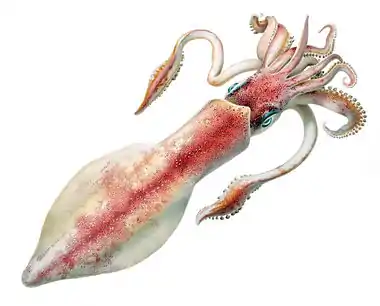| Loligo forbesii | |
|---|---|
 | |
| Scientific classification | |
| Domain: | Eukaryota |
| Kingdom: | Animalia |
| Phylum: | Mollusca |
| Class: | Cephalopoda |
| Order: | Myopsida |
| Family: | Loliginidae |
| Genus: | Loligo |
| Species: | L. forbesii |
| Binomial name | |
| Loligo forbesii Steenstrup, 1857[1] | |
| Synonyms | |
| |
Loligo forbesii (sometimes erroneously[3] spelled forbesi), known commonly as the veined squid and long-finned squid, is a commercially important species of squid in the family Loliginidae, the pencil squids.
Description
This squid grows up to 90 centimetres (35 in) in mantle length. The long fins are roughly diamond-shaped and make up two thirds of the total length of the body. The colour of the squid is variable, but is usually a shade of pink, red, or brown. The vestigial shell is a small, thin internal structure.[4]
Distribution
Loligo forbesii can be found in the seas around Europe, its range extending through the Red Sea toward the East African coast.[5] It is widespread in the Atlantic Ocean.[6] It is one of the most common cephalopods in the Celtic Sea.[7]
Biology
The squid lives at depths of 10 to 500 metres (33 to 1,640 ft). It attains sexual maturity at about one year old and lives 1 to 2 years, with a maximum life span of about 3 years. It generally breeds only once. The male delivers sperm into the mantle of the female using structures on a specialized tentacle. The female will spawn up to 100,000 eggs, which adhere to the sea floor.[6] Peak spawning season is in January through March off Scotland, with recruitment of juveniles occurring in the fall.[8] Off Galicia the breeding season lasts from December to May, with most mating occurring in December through February.[9]
The diet includes fish, polychaetes, crustaceans, and other cephalopods,[10] often members of its own species.[6]
Fisheries
This is one of the most common squid species fished in the United Kingdom.[11]
References
- ↑ Philippe Bouchet (2018). "Loligo forbesii Steenstrup, 1856". World Register of Marine Species. Flanders Marine Institute. Retrieved 12 February 2018.
- ↑ Loligo forbesii. Integrated Taxonomic Information System. (ITIS).
- ↑ Bouchet, P. and S. Gofas. (2013). Loligo forbesi Steenstrup, 1856. World Register of Marine Species. Accessed 5 June 2013.
- ↑ Wilson, E. Loligo forbesi: Long finned squid. Archived 2013-03-13 at the Wayback Machine Marine Life Information Network: Biology and Sensitivity Key Information Sub-programme [on-line]. Plymouth: Marine Biological Association of the United Kingdom. 2006. Accessed 5 June 2013.
- ↑ Bouchet, P. (2013). Loligo forbesii Steenstrup, 1857. World Register of Marine Species. Accessed 5 June 2013.
- 1 2 3 Taylor, R. 2002. Loligo forbesii. Animal Diversity Web. Accessed June 5, 2013.
- ↑ Hogan, C. M. (Lead Author) and P. Saundry (Topic Editor). Celtic Sea. In: Cleveland, C. J., Ed. Encyclopedia of Earth. Environmental Information Coalition, National Council for Science and the Environment. Washington, D.C. Published October 14, 2009, revised May 13, 2013, retrieved June 5, 2013.
- ↑ Pierce, G. J., et al. (1998). Distribution and abundance of the fished population of Loligo forbesi in Scottish waters: analysis of research cruise data. ICES Journal of Marine Science 55 14-33.
- ↑ Guerra, A. and F. Rocha. (1994). The life history of Loligo vulgaris and Loligo forbesi (Cephalopoda: Loliginidae) in Galician waters (NW Spain). Fisheries Research 21(1–2) 43–69.
- ↑ Roper, C. F. E., et al. 1984. Loligo forbesi, Veined squid. FAO Species Catalogue. Vol 3. Cephalopods of the World. FAO Fisheries Synopsis 125(3).
- ↑ Stroud, G. D. Squid. Torry Advisory Note No. 77. Torry Research Station. Ministry of Agriculture, Fisheries and Food. 2001.
External links
 Media related to Loligo forbesii at Wikimedia Commons
Media related to Loligo forbesii at Wikimedia Commons Data related to Loligo forbesii at Wikispecies
Data related to Loligo forbesii at Wikispecies